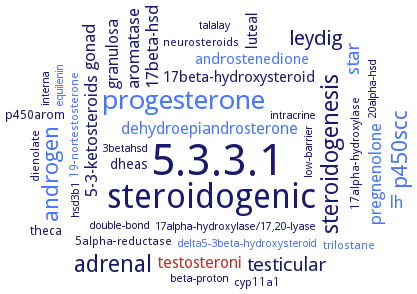5.3.3.1: steroid DELTA-isomerase
This is an abbreviated version!
For detailed information about steroid DELTA-isomerase, go to the full flat file.

Word Map on EC 5.3.3.1 
-
5.3.3.1
-
steroidogenic
-
progesterone
-
adrenal
-
steroidogenesis
-
androgen
-
p450scc
-
leydig
-
star
-
testicular
-
pregnenolone
-
17beta-hsd
-
lh
-
aromatase
-
5-3-ketosteroids
-
gonad
-
testosteroni
-
granulosa
-
dehydroepiandrosterone
-
luteal
-
androstenedione
-
17beta-hydroxysteroid
-
dheas
-
theca
-
p450arom
-
17alpha-hydroxylase
-
neurosteroids
-
cyp11a1
-
trilostane
-
19-nortestosterone
-
dienolate
-
5alpha-reductase
-
equilenin
-
low-barrier
-
17alpha-hydroxylase/17,20-lyase
-
interna
-
3betahsd
-
delta5-3beta-hydroxysteroid
-
intracrine
-
double-bond
-
hsd3b1
-
talalay
-
20alpha-hsd
-
beta-proton
- 5.3.3.1
-
steroidogenic
- progesterone
- adrenal
-
steroidogenesis
- androgen
- p450scc
- leydig
- star
- testicular
- pregnenolone
- 17beta-hsd
- lh
- aromatase
-
5-3-ketosteroids
- gonad
- testosteroni
-
granulosa
- dehydroepiandrosterone
- luteal
- androstenedione
-
17beta-hydroxysteroid
- dheas
-
theca
- p450arom
- 17alpha-hydroxylase
-
neurosteroids
- cyp11a1
- trilostane
- 19-nortestosterone
-
dienolate
-
5alpha-reductase
- equilenin
-
low-barrier
- 17alpha-hydroxylase/17,20-lyase
-
interna
- 3betahsd
- delta5-3beta-hydroxysteroid
-
intracrine
-
double-bond
- hsd3b1
-
talalay
- 20alpha-hsd
-
beta-proton
Reaction
Synonyms
3-Keto-DELTA5-steroid isomerase, 3-Ketosteroid DELTA5-->DELTA4-isomerase, 3-ketosteroid isomerase, 3-Oxo steroid DELTA4-DELTA5-isomerase, 3-Oxo-delta5 steroid isomerase, 3-oxo-DELTA5-steroid isomerase, 3-Oxosteroid DELTA4-DELTA5-isomerase, 3-Oxosteroid DELTA5-DELTA4-isomerase, 3-Oxosteroid isomerase, 3beta-HSD, 3beta-HSD/isomerase, 3beta-hydroxysteroid dehydrogenase/5-ene-4-ene isomerase, 3beta-hydroxysteroid dehydrogenase/DELTA5-DELTA4 isomerase, 3beta-hydroxysteroid dehydrogenase/isomerase, 3beta-hydroxysteroid dehydrogenase/isomerase type 1, 3beta-hydroxysteroid dehydrogenase/isomerase type 2, 3KSI, 5-Ene-4-ene isomerase, 5-Pregnene-3,20-dione isomerase, delta 5-3-ketosteroid isomerase, DELTA-3-ketosteroid isomerase, Delta-5-3-ketosteroid isomerase, DELTA5(or DELTA4)-3-keto steroid isomerase, DELTA5-3-keto steroid isomerase, DELTA5-3-ketosteroid isomerase, DELTA5-3-oxosteroid isomerase, DELTA5-ketosteroid isomerase, DELTA5-steroid isomerase, glutathione transferase A3-3, GST A3-3, Hydroxysteroid isomerase, Isomerase, steroid DELTA, ketosteroid isomerase, KSI, More, Steroid 5-->4-isomerase, Steroid isomerase, TI, TI-WT, type I 3beta-hydroxysteroid dehydrogenase/isomerase


 results (
results ( results (
results ( top
top





